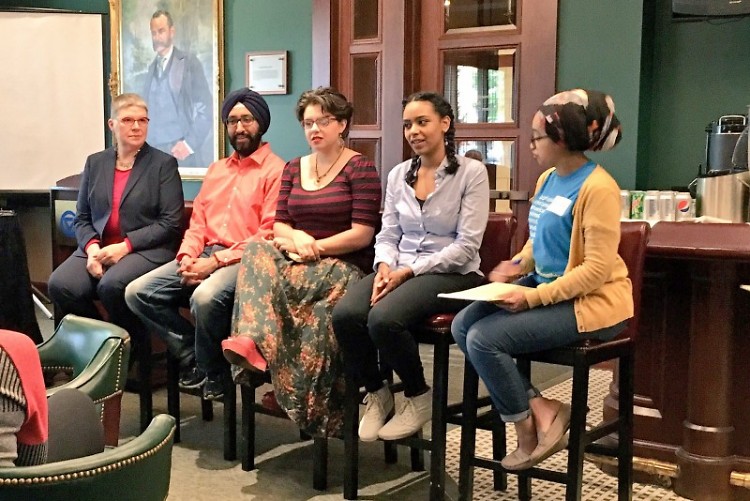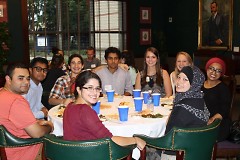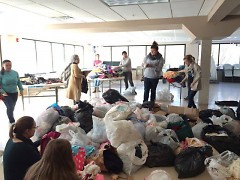At the beginning of 2016, I wrote an article suggesting that as a city, Grand Rapids’ New Year’s Resolution should be to get to know our neighbors of various faith traditions. At the time, I was motivated by the increasingly vitriolic rhetoric, exclusionary policy proposals, and resulting hate crimes against minority groups. By building relationships with our neighbors, a value that is found in all traditions, I suggested that it would lead to deeper understanding, respect, and appreciation for the differences we hold, and thus a community that embraces and thrives off of diversity and authentic engagement.
Nearly one year later, and the national climate we find ourselves in is even worse – more hateful and divisive than just a year ago. But the question remains: have we gotten to know our neighbors? Are we any better off, or further set behind by a society more divided than united?
When one reads the national news headlines or views trends across the United States, we often hear of the pain, marginalization and violence.
However, when we focus in on local contexts, we can find reasons to hope. We see stories of coming together, getting to know one another, that can not only send ripples of hope into our communities, but show a way forward in our small, daily encounters.
The following are just four stories of hope from our own interfaith community, led by the Kaufman Interfaith Institute and our numerous, committed community partners. These stories barely scratch the surface of this past year’s activities, but they start to reveal the power and potential of bridging our community by getting to know our neighbors.
Welcoming Refugees to Grand Rapids
Last winter, various organizations and community members came together to address the needs of newly arriving refugees, particularly those arriving from war-torn Syria. For two days in January and February, students from Grand Valley State University traveled to Masjid AT-Tawheed, Grand Rapids’ largest mosque, where two classrooms were overflowing with clothing for refugees donated from a partner church. Students spent hours sorting clothes, learning about the Syrian conflict and refugee crisis, and meeting members of the local Muslim and refugee community. Then, in March, an evening event entitled “Welcoming Refugees: Do Unto Others” had over 400 people from various traditions come together to hear stories of from former refugees like Mustafa and Flory, Elodie, Abigael, and Benedicte. These stories and conversations moved many from passive concern into intentional action – as a result, individuals, families, and congregations connected with local refugee resettlement and advocacy efforts.
Learning from Faith Matters Network
Later in the spring, Reverend Jennifer Bailey spoke to our community about her experience leading an organization called the Faith Matters Network, whose mission is to train, connect, convene and amplify marginalized people of faith, primarily people of color, “to chart a new moral horizon.” Bailey spoke to an audience of students and community members of all traditions about the way all faith and spiritual commitments can promote prophetic voices to challenge injustice and oppression. Her focus on the “ethic of accompaniment,” walking alongside those who are marginalized or oppressed, is an approach that has remained in the minds of many in the interfaith community here – who now articulate their own allyship in a variety of social justice movements as a form of accompaniment.
Interfaith Leadership Lab
In late summer, the Kaufman Interfaith Institute collaborated with national organization Interfaith Youth Core to host an Interfaith Leadership Lab, meant to train area college students to become interfaith leaders that further create spaces of positive encounter across religious difference on their own campuses. With over 50 students participating from 10 campuses in Michigan throughout the weekend, the time together included a Shabbat (Sabbath) Dinner hosted by Hillel Campus Alliance of Michigan, an all-day training on Saturday, and an interfaith service project at Blandford Nature Center on Sunday. Students from various campuses shared their own stories of identity, learned from community members representing diverse traditions, and engaged in common action rooted in the shared value of conservation.
17th Annual Interfaith Thanksgiving Celebration
Finally, in the fall, we celebrated the 17th Annual Interfaith Thanksgiving Celebration – a night where people representing various religious, spiritual and secular identities share their own messages of why their tradition promotes coming together and welcoming all. We heard songs from Baha’i and Buddhist kids’ choirs, recitations from the Qur’an and psalms from the Bible, reflections on gratitude from Jewish and atheist community members, and keynote remarks from Faye Richardson-Green. Richardson-Green, as Executive Director of Partners for a Racism-Free Community, shared a reflection on what it means to be an inclusive community – and challenged us to think of ways we can make sure everyone not only feels welcome, but feels wanted by the broader community. Following the service, the nearly 700 people who squeezed into the sanctuary stuck around for food and fellowship with one another, taking advantage of the time to share space and conversation with our neighbors of different traditions.
These are just four examples of the ways people in Grand Rapids got to know their neighbors throughout the past year, despite and perhaps emboldened by the divisive political climate. Beyond these examples, even, people came together every day to work on collaborative projects toward the common good. Each example of an encounter, conversation, or relationship across religious difference, sends a ripple – a sign of hope – into our community. The ways we grow as individuals, as people of conviction, and as communities of faith, hold much potential to transform our views of the “other” and our city as a whole.
This coming year, we remain committed to providing opportunities to build bridges of understanding and cooperation across our community, and we aim to be a beacon of hope in an otherwise discouraging climate of division. If enough local efforts such as ours occur, we hope that getting to know our neighbors transform not only our individual communities, but our nation at large. We need it more than ever before.
The Rapidian, a program of the 501(c)3 nonprofit Community Media Center, relies on the community’s support to help cover the cost of training reporters and publishing content.
We need your help.
If each of our readers and content creators who values this community platform help support its creation and maintenance, The Rapidian can continue to educate and facilitate a conversation around issues for years to come.
Please support The Rapidian and make a contribution today.



